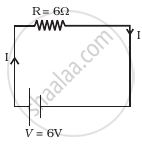Advertisements
Advertisements
Question
Consider the following statements.
(A) Free-electron density is different in different metals.
(B) Free-electron density in a metal depends on temperature.
Thomson Effect is caused _______________ .
Options
due to both A and B
due to A but not due to B
due to B but not due to A
neither due to A nor due to B
Solution
due to B but not due to A
If a metallic conductor has non-uniform temperature distribution along its length, the density of the free electrons is different for different sections. The electrons diffuse from the sections with higher concentration to those with lower concentration of free electrons. Thus, there is an emf inside the metal that is known as Thomson emf. If a current is forced through the given conductor, positive and negative work is done on the charge carriers, depending on the direction of current. Thus, thermal energy is either produced or absorbed. Thus, the correct cause of the given effect is given by statement B alone.
APPEARS IN
RELATED QUESTIONS
What is its relation with relaxation time?
Estimate the average drift speed of conduction electrons in a copper wire of cross-sectional area 2·5 × 10−7 m2 carrying a current of 2·7 A. Assume the density of conduction electrons to be 9 × 1028 m−3
The number density of free electrons in a copper conductor is 8.5 × 1028 m−3. How long does an electron take to drift from one end of a wire 3.0 m long to its other end? The area of cross-section of the wire is 2.0 × 10−6 m2 and it is carrying a current of 3.0 A.
How does drift velocity of electrons in a metallic conductor vary with increase in temperature? Explain.
On the basis of electron drift, derive an expression for resistivity of a conductor in terms of number density of free electrons and relaxation time. On what factors does resistivity of a conductor depend?
Explain the term ‘drift velocity’ of electrons in conductor. Hence obtain the expression for the current through a conductor in terms of ‘drift velocity’.
Derive an expression for drift velocity of free electrons in a conductor in terms of relaxation time.
When a current is established in a wire, the free electrons drift in the direction opposite to the current. Does the number of free electrons in the wire continuously decrease?
Consider the following statements.
(A) Free-electron density is different in different metals.
(B) Free-electron density in a metal depends on temperature.
Seebeck Effect is caused _____________ .
Obtain the expression for the current flowing through a conductor having number density of the electron n, area of cross-section A in terms of the drift velocity vd .
An electric bulb.is rated 220 v and 100 watt power consumed by it when operated on 'no volt is:-
The drift velocity of a free electron inside a conductor is ______
Is the momentum conserved when charge crosses a junction in an electric circuit? Why or why not?
- Consider circuit in figure. How much energy is absorbed by electrons from the initial state of no current (ignore thermal motion) to the state of drift velocity?
- Electrons give up energy at the rate of RI2 per second to the thermal energy. What time scale would one associate with energy in problem (a)? n = no of electron/volume = 1029/m3, length of circuit = 10 cm, cross-section = A = (1mm)2

Define relaxation time.
Explain how free electrons in a metal at constant temperature attain an average velocity under the action of an electric field. Hence, obtain an expression for it.
Two conductors, made of the same material have equal lengths but different cross-sectional areas A1 and A2 (A1 > A2). They are connected in parallel across a cell. Show that the drift velocities of electrons in two conductors are equal.
